by Tom Gaylord, a.k.a. B.B. Pelletier
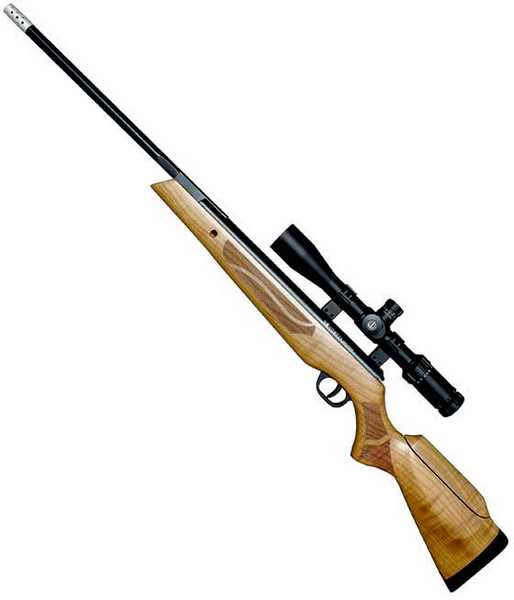
The Cometa Fusion Premier Star is stunning! This is the actual test rifle.
Well, today is do or die for the Cometa Fusion Premier Star air rifle. The last report was back in early November of last year, but that doesn’t mean I haven’t been working on the gun. Several times, I’ve started a test, thinking that I finally got the scope movement problem resolved — and each time a problem has cropped up. If I didn’t believe this rifle had potential, I would have given up long ago; but the .177 version of the rifle — the regular Cometa Fusion air rifle, was so accurate that I felt this one had to be, as well. Today, we’ll find out if it was worth the effort.
Thanks to Kevin
I want to publicly thank blog reader Kevin for all his help with this troublesome test. He sent me an adjustable mount that unfortunately did not hold on the test rifle, but he made a special scope stop pin that will be used today. If you read the past reports, you’ll discover that this rifle has a severe drooping problem. It needs as much scope alignment correction as you can possibly get. I used a special UTG drooping scope base that’s a prototype you cannot buy for today’s test, but I only did so to accommodate Kevin’s stop pin. You should be good with any droop-compensating mount as long as you have the right scope stop pin to fit the gun. I’ll say more on that in a moment, but first let me admit this is the very first air rifle I’ve seen that could defeat the BKL mounts. The one I tried slipped off the gun in five shots. In fairness to BKL, though, this rifle also broke other scope stop pins — and in one case dragged one through the top of the spring tube until it popped free. So, this is a special case.
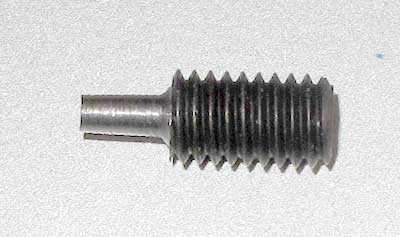
Kevin made this scope stop pin for the Cometa. It saved the day!
Those are NOT scope stop pin holes!
Well, excuse me! Those four holes on top of the spring tube that I thought all along were scope stop holes must not be there for that purpose; because if you insert a stop pin too far through any one of them, you’ll bind the action. The gun will not cock! So, not only are they too small in diameter, they’re also very critical of the depth to which the stop pin is inserted! I took some pictures to show you what I mean.
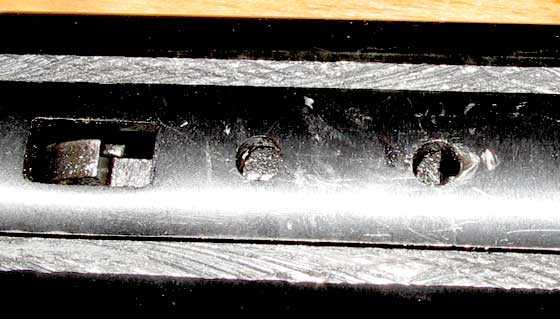
Looking down through the rear “scope stop pin” holes, you can see parts that move when the rifle is cocked. You can also see where, in an earlier attempt to anchor a scope, a pin ripped out of the rear hole.
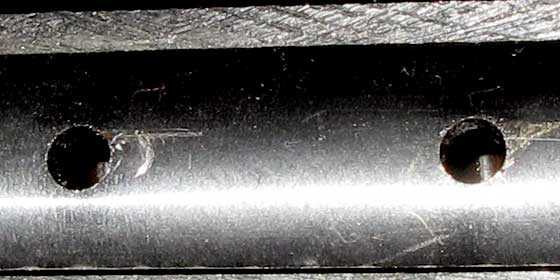
Looking down through the front “scope stop pin” holes reveals the mainspring coils. The gun will lock up and fail to cock if you insert a scope stop pin too deep in these holes.
Nevertheless, I was able to engage one of the front holes enough to finally anchor the scope base, thanks to Kevin’s pin. Now, it was possible to do some shooting.
Is the bore too large?
I did several things to prepare the Fusion Premier Star for this test. I cleaned the barrel with J-B bore paste. I also tightened the barrel in the fork, so it’ll stay wherever it is put after the rifle’s cocked. That’s the test of a properly tight pivot point — one that will keep the breech sealed upon firing. But since none of the scope mounts have worked until today, none of my shooting before today has been successful.
I also began to wonder if Cometa had used a .22 rimfire barrel for this rifle. That would explain the failure to group because the bore of a .22 rimfire is about 5 thousandths too large for normal pellets. A .22-caliber pellet rifle bore is supposed to be no larger than 0.218 inches in diameter, where a .22 rimfire barrel is 0.223 inches across. It makes such a huge difference that there is no chance of shooting well with the rimfire barrel and standard pellets.
H&N Field Target Trophy
Because of that, I decided to test the rifle with overly large pellets, as well as normal-sized pellets, to see if there was any obvious difference. The first pellet I tried at 25 yards was the H&N Field Target Trophy with a large 5.55mm head. Pyramyd AIR has these pellets with head sizes of 5.52, 5.53, 5.54 and 5.55mm.
I was using the pellets with the 5.55mm head. They loaded very tight in the breech, as you might imagine. The first group of 10 I shot was large, but inside the main group were 5 rounds in a smaller hole. That prompted me to shoot a second 10-shot group, which showed me what this pellet is capable of.
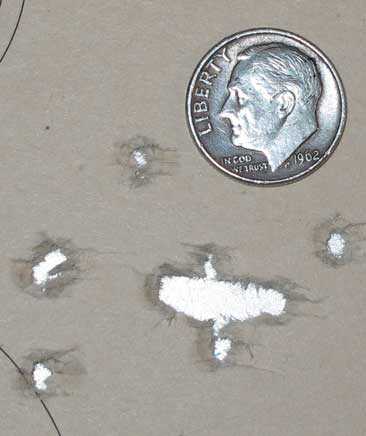
The main group is a little large, at 1.432 inches between centers, but the five in one hole are just 0.456 inches apart.
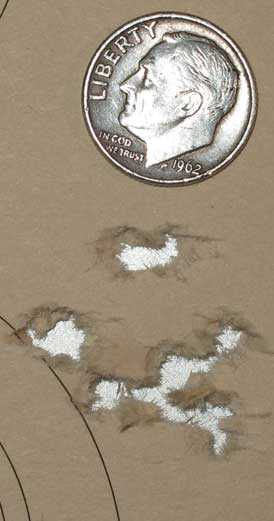
Here are 10 H&N Field Target Trophies in a 0.883-inch group. I think this is what the rifle is capable of at 25 yards.
JSB Exact 15.9-grain
Next, I tried the 15.9-grain JSB Exact dome that often does so well in .22-caliber spring-piston rifles. I stopped after just three shots, and I’m showing you those shots so you know why I stopped. I know many of you feel that the barrel needs to be “seasoned” with each new pellet — meaning that a number of pellets must be shot before any official recording can be done — but this spread is already larger than 2 inches, and I’m saying that seasoning isn’t going to help things that much.
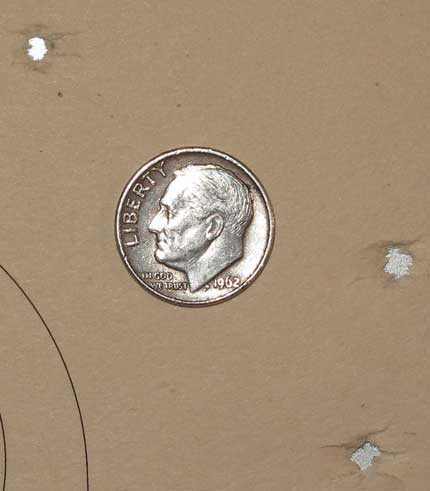
Yes, I really do shoot those other groups that aren’t always shown. I doubt “seasoning” the bore will save this pellet. JSB Exact 15.9-grain dome.
5.56mm Eley Wasp
Was this a .22 rimfire barrel? It was starting to look like it, because the larger H&Ns did well and the JSBs did so poorly. But the proof of the pudding is to shoot the largest pellet of all and see what happens. That would be the obsolete 5.56mm Eley Wasp. If it also shoots well, then I’m thinking the barrel is a rimfire barrel.
Well, Wasps were not good. They made the same 2-inch spread the JSBs did with only three shots, so I stopped shooting them. I won’t show the shots because you know what a 2-inch group looks like. But at least I believe this barrel is not from a rimfire.
Beeman Kodiaks
Next, I wanted to try a heavy pellet that’s not necessarily a large one — the Beeman Kodiak. They fit the breech well — neither too large nor too small. And the first three shots were looking good, but shot 4 went to the right. In the end, I had a horizontal group that was a little large, but stayed at the same height for all 10 shots. I don’t think the Kodiak is the right pellet for this rifle.
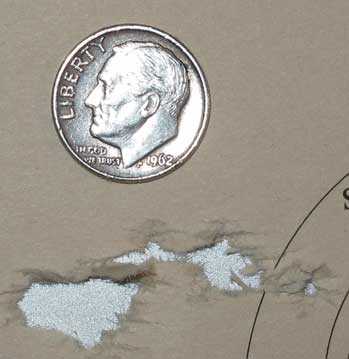
Beeman Kodiaks weren’t terrible — they just weren’t as good as the H&N Field Target Trophies. This one measures 1.202 inches between centers.
Overall evaluation
I was disappointed by the .22-caliber Fusion after the .177 had done so well. In the end, I did get the rifle to shoot, but it took every trick in the book to get there. I can recommend the .177 version of this rifle, because I really like the adjustable cheekpiece and the adjustable trigger. But the .22 took too much to get it to shoot.

Sigh.
Well…..no one can say B.B. didn’t go an extra two miles for this one.
I really wanted this .22 caliber cometa fusion to work out. The past reports of the trigger, adjustable cheek piece, weight, etc. had me very intrigued.
Kevin,
So did I. I had hoped that a new R9 challenger had come along. Perhaps it is in .177 caliber, but not in .22.
B.B.
My sentiment exactly. Never let it be said that B.B. doesn’t give guns a fair chance.
Matt61
Hello B.B. and fellow blog readers. This Cometa Fusion Premier comes across as a bit of a contradiction. If it has the power of the Beeman R1, then, as you have recommended many times, a .22 is the way to go. But the .177 cal has the accuracy we need for dispatching pests and shooting one hole groups at 25 + meters. The .22 cal of this test, showed some promise with the H+N FTT pellets when you put five in a single hole. However, they aren’t doing this with any consistency. And that is what I look for in a gun. AS for the .177 being too small for squirrels and rabbits, I think this gun will deliver 15-17 flbs of energy with a heavy pellet. Combine this with decent accuracy, and I believe it to be up to the task. To side track a bit, I think a gun like this would be great in .20 cal. I have recently put a .20 cal barrel on my HW80, and it is a different gun. There is no one thing I can put my finger on. Nice one hole half inch groups at 16 meters. Sixteen being the furthest I can shoot outside in the winter. Because I am new to this calibre, maybe you could do a blog on the pluses and minuses of the .20 calibre. After all, it is Dr. Beeman’s calibre of choice. You can’t get a better recommendation then that. Thanks for all the effort you put into testing this gun for us. I salute your tenacity and patients.
Caio Titus
I’m almost tempted to suggest carefully pulling the bullets from a package of .22short rimfire — after all, if this is a .223 barrel, those should be a better match… Heavy, with no hollow base stabilization (unless one can rig a slow speed drill on a press and carefully cut into the base of the bullets).
Wulfraed,
How would I load them? When you load solid bullets, your thumb becomes a short starter. It is virtually impossible to load solid bullets into an airgun barrel by hand.
Once in, the twist rate and velocity would be too low to stabilized the bullet. S0 no accuracy, anyhow.
B.B.
RE: “hollow base stabilization”
I think you misunderstand how a diabolo pellet is drag stabilized. The air flows over the head and “down” into the wasp waist. Then the air must spread again to go over the conical tail. The airflow over the conical tail creates the drag stabilization. A bullet has some base drag, but nearly enough to stabilize its flight.
Hollowing the base would still produce a front-loaded center-of-gravity relative to the center-of-drag… Just as with many old-style shotgun slugs.
I’ve heard that pulling rimfire bullets is extremely dangerous.
Matt61
Well, you definitely do NOT use a hammer-type bullet puller…
Nor pliers on the case… A lot of finger wiggling might suffice, though shorts are so short getting a safe hand grip on both case and bullet would be tricky. Long rifle would be easier — but I didn’t want to consider a 40gr LR bullet; even a 28-29gr short is going to be on the excessive end for a spring gun (that’s the weight range of some of the Eun Jin pellets)
Good morning to all, i discovered this blog about 18 months ago and found it to be one of the most honest and understandable blogs on airguns to date. I started reading the daily blog and then religiously followed the older blogs through their time line,its taught me a lot i did not know and pushed me to persue ideas i would not of thought of. Not just the blog but the comments as well are a constant source of knowledge, wisdom, and humour.
.
Most of all i’m totally impressed with the honest evaluations of both older classic guns and the more modern products sold by PA. You don’t find many company blogs that inform you a certain rifle is poorly made, has a stiff trigger, or is impossible to cock for example, and then you are shown a myriad ways to improve any problems if possible. So when a rifle is put through the B.B. wringer and is highly praised then i know that rifle is going to be as good as i’m told it is, no fluff, no bunkum, just an intelligent, informative, honest, reliable review with a lot of invaluable comments.
I’ve been an air rifle enthusiast for over 30 years and i reckon I’ve learned more about air rifles in the last 18 months than in all the previous years put together, my marksmanship has certainly improved and i thought i was pretty good before that. So a big thank you to you all and i look forward to all future blogs to come.
TTFN
Most humbley yours, wing commander Sir Nigel Tetlington-Smythe
Sir Nigel,
It is for people in your position that I write this blog. I believe, along with Pyramyd AIR, that when a person knows the truth before the purchase, they may still want to buy what they want — even though it has a drawback or two. And that is certainly better than having them find out the truth on their own after the sale!
B.B.
Ah, so goatboy is Sir Nigel. My question is answered.
Matt61
Some just like one pellet. My CFX really liked the 4.52mm FTT. It did not like the 4.51mm. It did not particularly care for any other pellet, but on those days I dropped into “The Zone”, It was phenomenal.
RR,
You are right, of course. I went through at least 10 of the best pellets in this rifle and what you see here is the best I ever got it to do.
There may be that one best pellet our there still.
B.B.
The holes in the spring tube smacks of an engineering change that did not work out. They then decided to dress the pig up in a nice jacket hoping we would buy it.
Pete
Are we next on the ban list?
http://tvnz.co.nz/national-news/teen-died-air-rifle-shot-heart-5318164/airgun-video
I had been wondering about how the M1 Garand fares with the NY laws. An email from the Civilian Marksmanship Program says that they will still ship M1s to NY, but they must be sent to a firearms dealer who can modify them according to the new law whatever that means.
I also learned how NY got around defining assault weapons. If it has even one evil feature it is an assault weapon. If there is doubt, there is no doubt…
Matt61
A clearly unconstitutional law that is costing NY big money. The big trade shows are headed else where! Also, it’s not just gun shows either!
Mike
That is disappointing! I still feel there is a nice gun hiding in there somewhere, but unfortunately it is out of reach of all but the expert airgun tinkers. Better luck next time, Cometa…
/Dave
It is a shame that they cheaped out on the barrel. It is a nice looking airgun and at the right power level for .22 but in the end the only 2 things that matter are accuracy and the trigger. At the price point of this gun there are many better choices and if they don’t get it sorted out quick it will develop the same rep as the Turkish Webleys and go the same way.
Tom,
Forgive me. I gotta ask. I know you tried many, many different pellets in that .22 cal cometa fusion. Were the JSB 18.1gr among them? Did you seat any of the pellets deeply?
kevin
Kevin,
I can’t remember trying 18.1-grain JSBs. And I did not seal any pellets in this test.
B.B.
BB
Is there any design features that would explain why a certain gun would be particularly accurate in one caliber but inaccurate in another, like this Cometa?
Fred,
Yes, if the barrels are sourced from different suppliers there can be a big difference.
B.B.
This is not the case with Cometa air rifles – all the barrels used in their models are manufactured inside the factory with their own machines. The firm also advertises this fact in every occasion. The are using cold hammer forging, if you visit their website you will see that in the front page: “…Cometa’s barrels are precisely drilled and later cold hammered in machines especially made for this process…”.
http://www.cometaairgun.com/en/cometa_presentacion.html
The factory generally follows the vertical integration of production in all their products (barrels, butts, mechanisms).
I am almost convinced that something else is going on here, something that has nothing to do with the rifle and its shooting behavior. I am interested in buying this rifle in the specific caliber and I will try to look deeper into the subject.
Thank you very much for the informations!
Accuracy lover,
Thank you for that information. I always like knowing the truth behind a product.
However, hammer forging is not the best way to make an accurate barrel. Oh, it does well and I have had some very good ones, like the barrel on a Ruger 10-22 Target, for instance. But some of the hammer-forged IZH 60 and 61 barrels leave something to be desired. Button rifling is better for a barrel, but it costs more (in time) after the hammer swage machine sunk cost is paid.
Thanks, again,
B.B.
Duskwight, I know how all the parts of a semiauto tend to retard accuracy. As for damage to the round, I think that must be due mostly to the violence of the moving bolt. It never fails to amaze me that the slide on a 1911 moves at almost Mach 2. On the other hand, the cartridge is moving within a precisely machined pathway so that, for example, the chamber that it lands in it fits the cartridge almost exactly without deforming it. But I don’t know how much these two opposite effects cancel each other.
However, this does raise a question for you reloaders. As I mentioned some time ago, while reloading for my Garand, I had one instance with a mild jam, and when I extracted the cartridge, the whole thing came apart with the bullet flying loose and the powder going all over the shooting bench and into my action. Now how in the world did that happen? It musn’t happen again. After reflecting on this for a long time, it occurred to me that the problem may lie in my quest for Overall Length perfection. What I would do is set the length of the dies a little long. Then incrementally reduce the length on repeated passes with the press until it was just right. Given the variability of the process, some cartridges ended up too short. So, I pulled the bullets and started over. Herein perhaps may be the problem. Once the mouth of the cartridge was opened, it no longer held as tightly as after the case is resized. So the lesson seems to be never to pull bullets to reseat them. True? I had wondered if the repeated passes through the press was also causing problems by opening the mouth even for the cartridges that turned out right. I don’t think so since multiple small insertions of the bullet seem to me to be physically equivalent to one of the same length. But the problem appears to be backing out the bullet and trying again.
Mike, that is amazing about your 90 year old friend the ball turret gunner. Get that man’s oral history. I understand that the ball turret was the worst spot to be in. I have a granduncle who was a top turret gunner and flight engineer for the B17, and he is not anxious to talk about the experience which included him being shot down and captured. He did finally write up his experience, and one lesson learned is that you want to be very sure that your guard doesn’t understand English before you mouth off to him. I had never heard of a computing gunsight on bomber’s guns although I have for the fighter planes. Reports were not that good. And I’m still skeptical of the claims for the Norden bombsight of the B-17s that they could drop a bomb in a pickle barrel from four miles up. Today’s smart bombs can hardly do that. I suspect that the bombing damage in WWII was caused by mass bombing tactics.
Matt61
The Norden bombsight wasn’t good enough to hit a barrel! But, it was better than other bombsights.
It was a early analog computer. I have talked to my friend and he has told me some tales! Stuff you just could not make up. Here’s one, a ME-109 came up under the bomber and hit it with machinegun fire. One bullet (7.9mm from the Cowl Guns) went through his knee (he still has the scar). When he got hit, he let go of the turret controls and the guns dropped straight down. The ME-109 kept coming almost straight up and in a stall. He said the pilot probably thought he was dead. Well, he wasn’t, he grabbed the controls and opened up. The ME exploded about 100 meters out. That was only one mission. He flew 30, the last four or five as a Co-pilot, but that is another story.
Mike
A bit of History. The 8th Air force flying bombing missions over Europe lost more personnel than the entire US Marine Corp did during WWII.
Mike
Sounds like you aren’t using any sort of neck crimp on those rounds…
B.B.,
Did the point of impact change a lot with the Beeman Kodiaks? It looks like that pellet wanted to group. Did it tend to shift much between pellets in general?
Victor
Victor,
Yes! Kodiaks dropped like a stone. They went down several inches, but I didn’t bother adjusting the scope for them.
B.B.
try using cometa exact jumbo heavy pellets [selected by jsb ]they are a 5.52 18 .13 grains .
dear b b i have had this gun for over a year now and tested many pellets , you need to use 5.52 head pellets in this gun ,the besr grouping pellet i have found so far are cometas own [selected by jsb ] they are 5.52 head [says 5.5 on tin ] but they are 5.52 ,exact jumbo heavy 1,175 grams /18,13 grains .
Chris,
Sorry, but the rifle has been returned.
B.B.